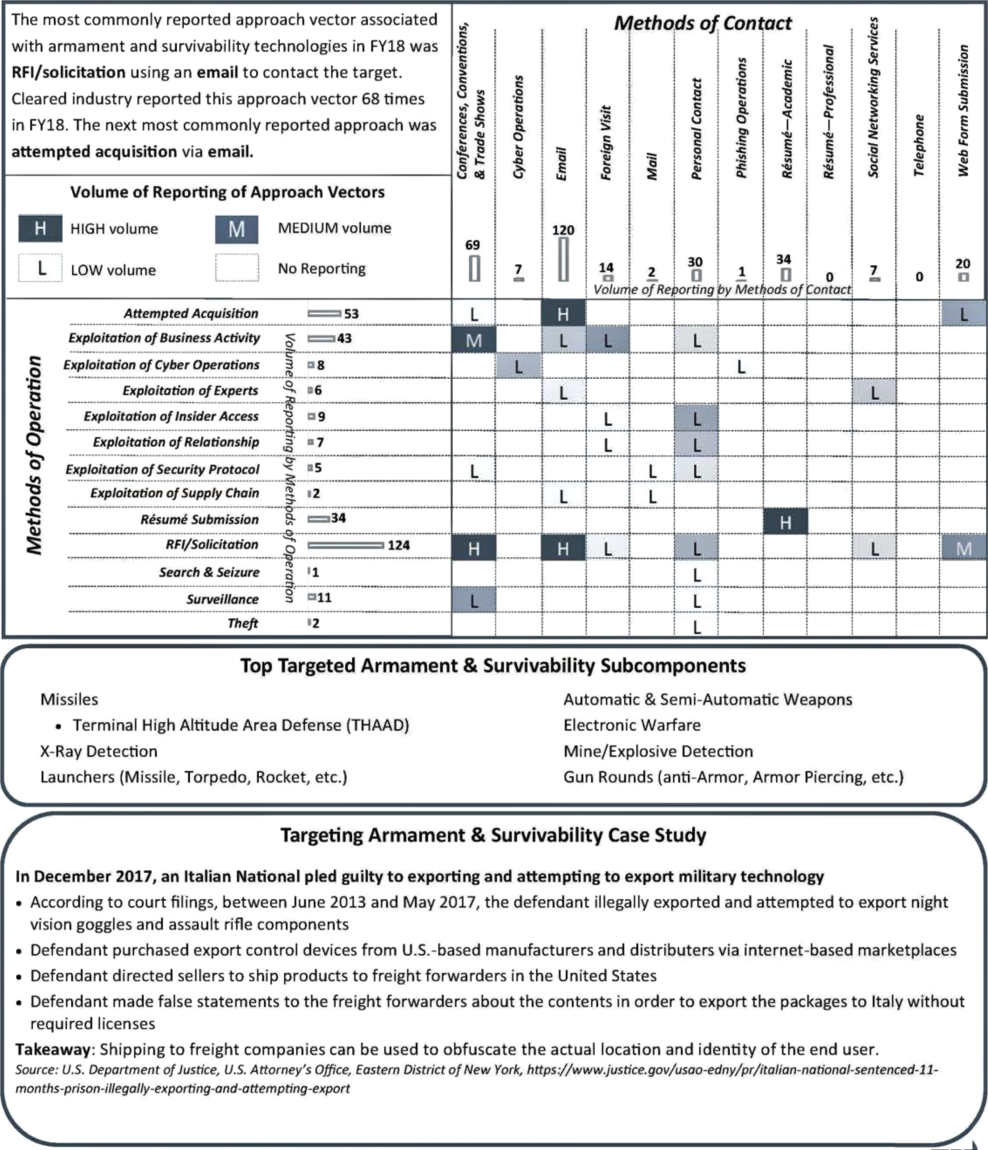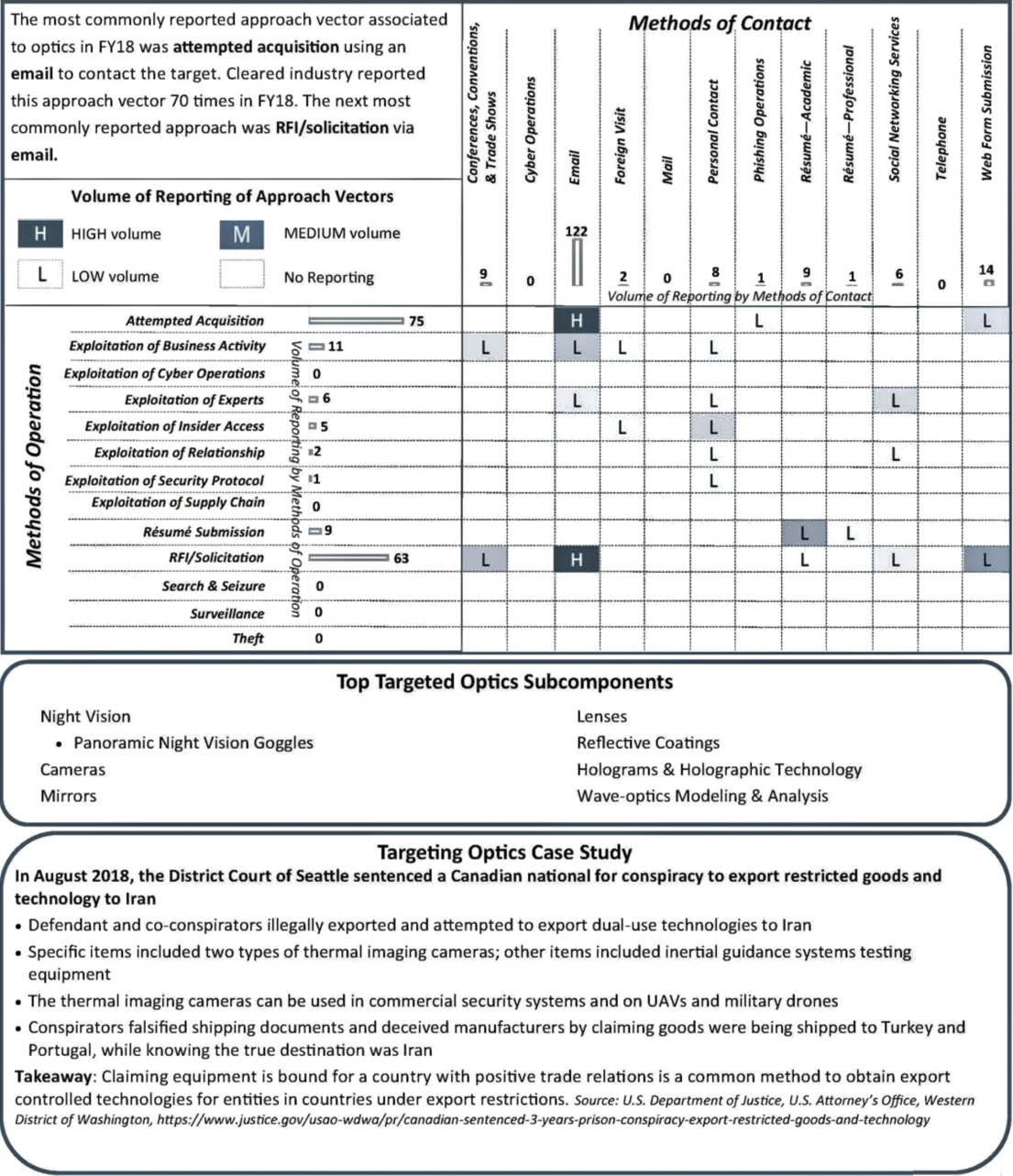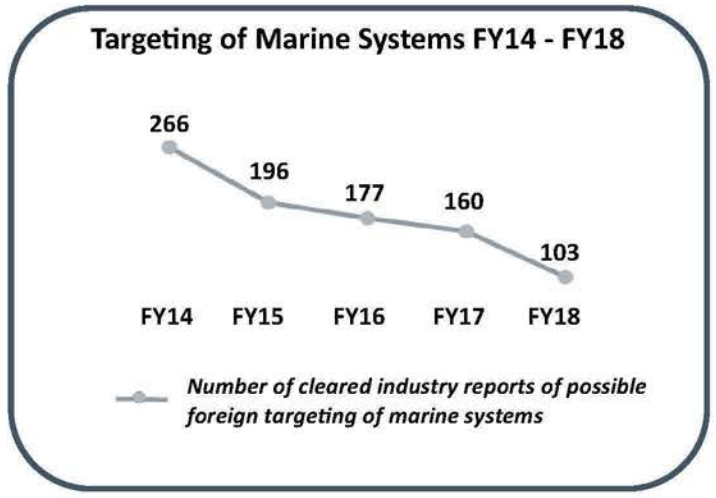Reported foreign targeting of armament and survivability
Armament and survivability
Armaments are the conventional munitions technologies designed to increase the lethality of ground, aeronautic, marine, and space systems. Conversely, survivability technologies provide various levels of protection for ground, aeronautic, marine, and space systems from armaments. Armament and survivability includes, but is not limited to, missiles, rockets, automatic and semi-automatic weapons, electromagnetic rail guns, artillery and mortar rounds, and body armor.
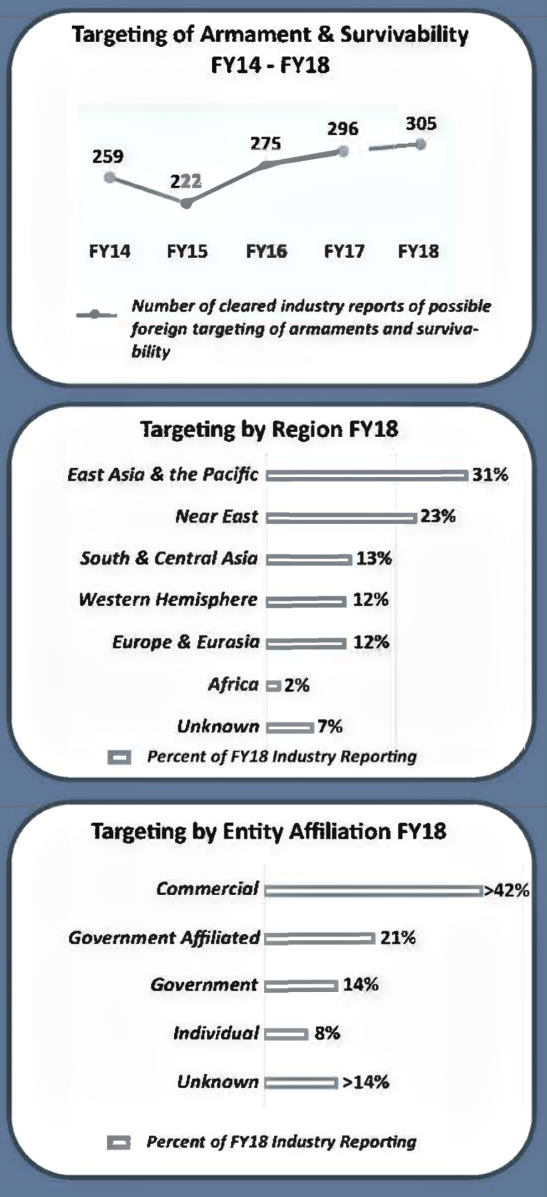
Key Findings from FY18 Cleared Industry Reporting
• Armament and survivability was the fourth most targetedtechnology category in FY1
• Reported targeting of armaments and survivabilitytechnology increased by 3 percent from FY1
• East Asia and the Pacific region was the origin of mostreported targeting of armament and survivability
• RFl/solicitation was the most common MO and email was themost common MC used to contact industry in attempts totarget armaments and survivability technologies
Overview
Every year since FY12, except for FY15, the number of incidents of targeting armaments and survivability has increased. FY18 is only the second year that armament and survivability has been one of the top five targeted technologies as rep orted by cleared industry. The most targeted technologies in this category included missiles, automatic and semi-aut omatic weapons, and electronic warfare.
Cleared industry reporting in FY18 identified entities from East Asia and the Pacific region in 31 percent of the incidents. The volume of reporting of East Asia and the Pacific entities targeting this technology increased by 8 percent in FY18. Entities from this region targeted missiles, automatic and semi automatic weapons, and electronic warfare.
Entities from the Near East were the next most active and were identified in 23 percent of the reporting. Entities from this region most often targeted missiles, automatic and semi automatic weapons, and missile warning systems.
Commercial entities were involved in over 42 percent of the incidents targeting this technology. In 55 percent of the incidents associated with commercial entities they used RFI/ solicitation as the MO.
In FY18, 41 percent of suspicious contacts listed RFl/solicitation as the MO, the second most common MO was attempted acquisition of technology noted in 17 percent of reports. Email was noted as the MC in 39 percent of the incidents targeting this technology, followed by conferences, conventions, and trade shows, reported in 23 percent of the reports.
Takeaway
The United States is a leader in developing and applying armament and survivability technologies, which include weapon systems and protective tec hnologies. Foreign adversaries that obtain sensitive information relating to these technologies can benefit from replicating U.S. capabilities and developing countermeasures to U.S. systems.
Foreign Collection Methodolgy Targeting Armament and Survivability
Foreign entities use appro-ach vectors that include an MO paired with an MC. The matrix below depicts the volume of reported incidents of targeting armament and survivability in FY18.
Reported Foreign Targeting of Optics
Optics is the study of the behavior of light and its interactions with matter and the development of equipment to detect light. Although other portions of the electromagnetic spectrum exhibit similar properties of light, the optics category refers to the study and detection of light in the visible, ultraviolet, and infrared portions of the electromagnetic spectrum. Optics includes, but is not limited to, cameras, fiber optics, lenses, mirrors, night vision, polarization, reflective coatings, and refractive coatings.
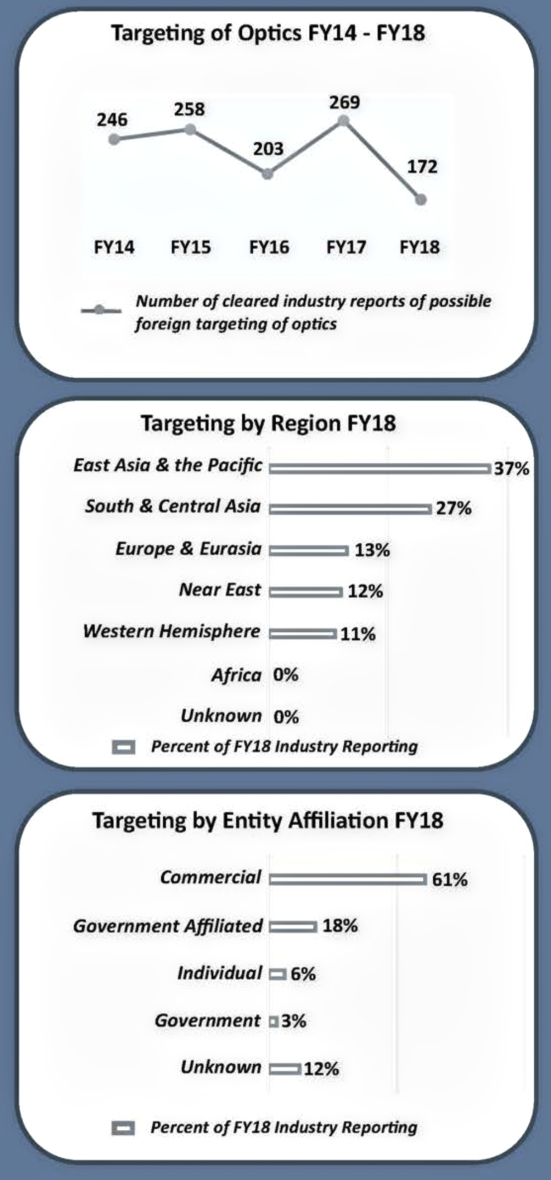
Key Findings from FY18 Cleared Industry Reporting
• FIE targeting of optics technologies decreased in FY18; however, it was the fifth most targeted technology
• The majority of foreign collectors targeting optics were commercial entities
• Attempts to purchase optics related technology was the most common approach, often via email
Overview
FY18 was the first year that optics was one of the five top targeted technologies since FY12 when it was a component of the laser, optics, and sensor category, despite experiencing a 36 percent decrease in reported targeting from FY17. The most targeted optics technologies were night vision, cameras, mirrors, and lenses.
East Asia and the Pacific region was the origin for 37 percent of the incidents reported by cleared industry relating to optics. The volume of targeting from this region decreased by 41 percent from FY17. Entities from East Asia and the Pacific targeted cameras and mirrors more than any other optic technology.
South and Central Asia entities were the next most prolific collectors of optics technology in FY18. Noted in over a quarter of the reports relating to optics, entities from South and Central Asia targeted night vision technology more than any other optic technology.
Commercial entities were by far the most common collectors identified in cleared industry reporting of targeting optics. These entities applied the attempted acquisition of technology and RFl/solicitation MO in nearly 90 percent of the incidents.
In FY18, the MOs attempted acquisition of technology and RFl/solicitation were the most used by FIE targeting optics. One of these MOs was identified in 81 percent of the incidents reported in FY18. Exploitation of business activity was the third most reported MO, accounting for just 6 percent of the incidents. By far, email was the most common MC used targeting optics. Cleared industry reporting listed email as the MC in 71 percent of the incidents.
Takeaway
Optics remains a highly sought after technology, even with the reduction of reported FIE targeting in FY18. High quality night vision provides an advantage to U.S. warfighters. FIE will continue to target U.S. optics technology for military and commercial uses. Once obtained, foreign entities can apply the technology and further proliferate it to other countries for commercial gain.
Foreign Collection Methodolgy Targeting of Optics
Foreign entities use approach vectors that include an MO paired with an MC. The matrix below depicts the volume of reported incidents of targeting optics in FY18.
Foreign Targeting of Other Technologies
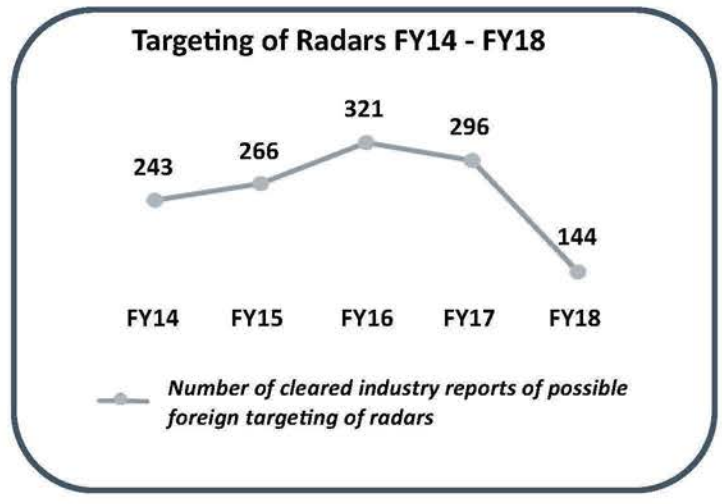
Radars
In FY18, 2 percent of the reports from cleared industry identified radars as the targeted technology. The reported targeting of radars has decreased over the past 2 years, dropping by 51 percent from FY17. The most frequently targeted radars in FY18 have ground forces applications with ground penetrating radar and through-the-wall radar accounting for 24 percent of targeted radar systems. Radars commonly associated with anti-access area denial (A2/AD) such as target acquisition, air defense, and early warning were noted in fewer incidents. In FY18, entities from the East Asia and the Pacific region were the most active collectors targeting radar. They accounted for 39 percent of the incidents, followed by the Near East and South and Central Asia regions. Commercial entities were noted in 49 percent of the incidents targeting radars.
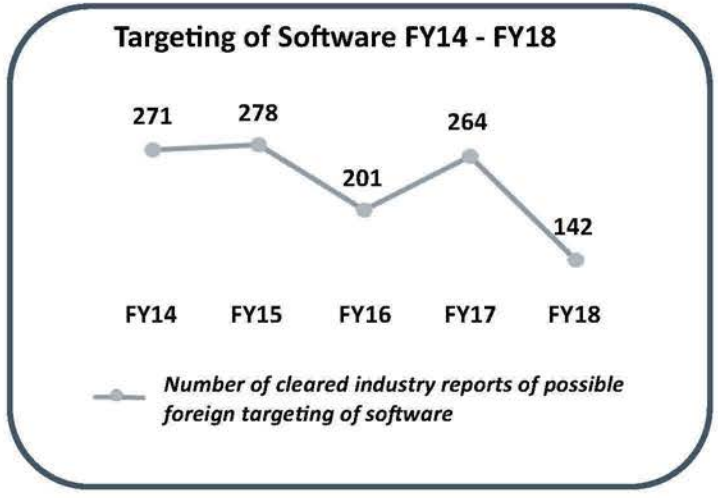
Software
Reporting from cleared industry of incidents relating to software accounted for 2 percent of all reports in FY18. The reports relating to targeting of software dropped by 46 percent in FY18. Cleared industry identified modeling and simulation software in 28 percent of the reporting. The next most reported software was artificial intelligence software, noted in 11 percent of the reporting. All other types of software were noted in less than 10 percent of the reports related to this category.
Not surprisingly, East Asia and the Pacific region entities were the most active collectors targeting software, accounting for 35 percent of the reporting in FY18. Europe and Eurasia entities were the second most active, identified in 25 percent of the reports. Commercial was the most active entity affiliation identified in 43 percent of the reports relating to software.
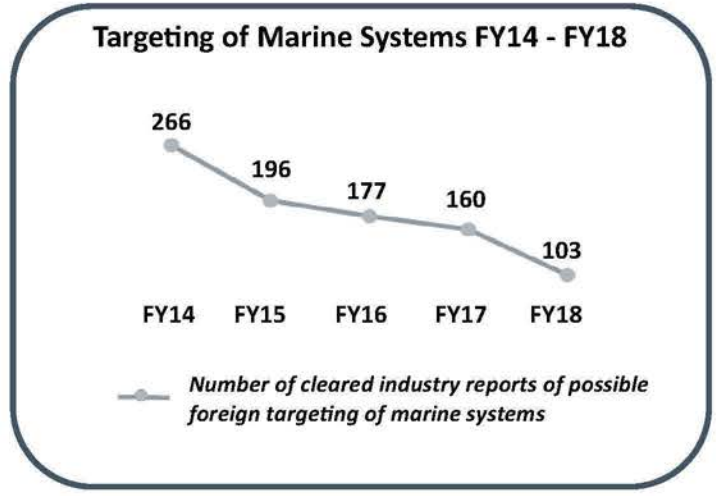
Space Systems
Cleared industry reporting of suspicious contacts identified space systems as the targeted technology in 2 percent of the reports in FY18. The volume of reporting related to space systems decreased by 22 percent from FY17. In FY18, one-third of the reports of targeting space systems involved satellite buses. A satellite bus is a general satellite model on which multiple satellites can be produced with different payloads.
DCSA identified East Asia and the Pacific region entities in 31 percent of the reporting associated with targeting of space systems. Entities from Europe and Eurasia were identified in 24 percent of the reporting in FY18, and entities from the Western Hemisphere were identified in 20 percent. Cleared industry reported commercial entities in 35 percent of the reporting and government affiliated entities in 34 percent.
Marine Systems
Since FY13, the targeting of marine systems has decreased each year. In FY18, marine systems were identified in under 2 percent of cleared industry reporting. The volume of incidents targeting marine systems dropped 36 percent from FY17. Of specific marine systems technologies, reports of targeting of combat ships and landing vessels decreased by 63 percent, and that of submarines and designs fell by 25 percent.
According to FY18 reporting, entities from East Asia and the Pacific region were involved in 48 percent of the incidents and Western Hemisphere entities were the second most active, noted in 17 percent of the reports. Commercial and government affiliated were the two most active entities targeting marine systems in FY18, accounting for 39 and 23 percent of the reporting, respectively.


Energy Systems
Energy systems was the tenth most targeted technology as reported by cleared industry in FY18. These technologies were targeted in just under 2 percent of cleared industry reporting. The East Asia and the Pacific region was the origin of over half of the reported attempts to collect on energy systems.
Targeted Energy Systems
• Gas Turbine Engines • Batteries • Propellants • Rocket Engines • Turbo Fan Engines • Ocean Power Technologies • Energy Systems Components • Generators


Positioning, Navigation and Time
Positioning, navigation, and time (PNT) accounted for the targeted technology in just over 1 percent of reporting in FY18. DCSA identified entities from East Asia and the Pacific region in 39 percent of the reports of targeting of PNT.
Targeted Positioning, Navigation, and Time
• Inertial Measuring Units • Gyroscopes • Global Positioning System (GPS) • Accelerometers • Navigational Aids • GPS Alternative Systems • Radio Frequency & other Beacon-Based Navigation Technology


Sensor (Acoustic)
Reported targeting of sensors (acoustic) technology increased by 122 percent in FY18 over FY17. Entities from East Asia and the Pacific accounted for 63 percent of reporting relating to sensors.
Targeted Sensor (Acoustic)
• Acoustic Sensor Products • Active Sonar • Sonobouys • Seismic Ground • Acoustic, Sensors, and Displays


Materials: Raw and Processed
In FY18 reporting, the number of incidents of targeting of materials: raw and processed, dropped by 40 percent from FY17. Entities from East Asia and the Pacific accounted for 58 percent of the reports.
Targeted Materials: Raw and Processed
• Fiber-based Materials • Plastic-Unique or Advanced • Chemicals • Alloys • Structural Foam


Ground Systems
Reported targeting of ground systems was up 7 percent from FY17. Entities from the Near East were the most active collectors identified in 28 percent of the SCRs.
Targeted Ground Systems
• Light Armored Vehicles & Designs • Medium Tactical Vehicles & Designs • Unmanned Ground Systems • Cargo Systems
• Transport Vehicles & Designs • Ml Abrams Variations of Heavy Tanks & Designs


Lasers
In FY18 the reported targeting of lasers decreased 27 percent from FY17. East Asia and the Pacific region entities were • Attempted Acquisition of Technology identified in 47 percent of the reports of targeting technologies and information relating to lasers.
Targeted Lasers
• Solid State Lasers • High Energy Laser Weapons • Gas Lasers • Fiber Lasers
Biological
Directed Energy
Agriculture
Part Two of the DCSA’s “Targeting U.S. Technologies: A Report of Foreign Targeting of Cleared Industry” will be presented in the May issue of MilsatMagazine.
www.dcsa.mil


